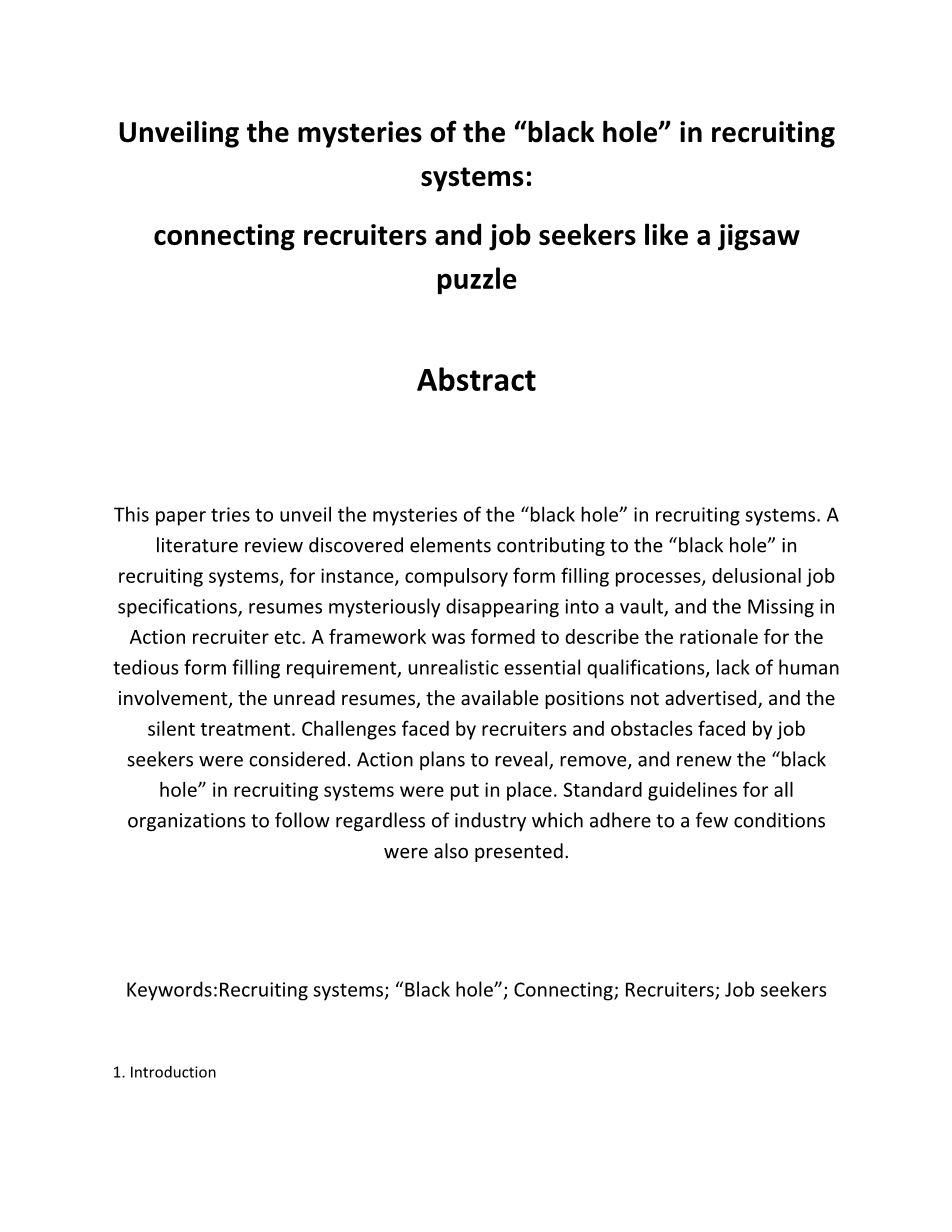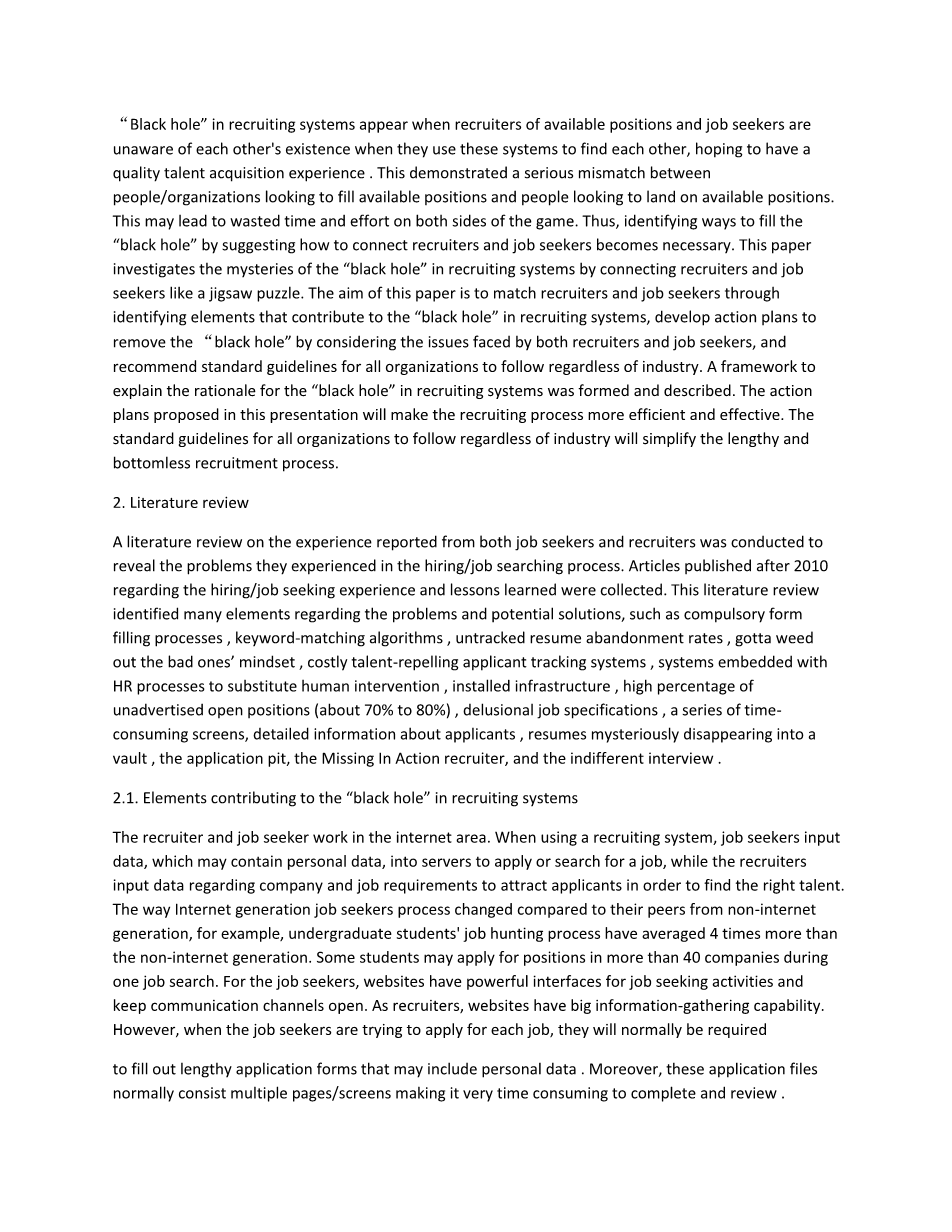Unveiling the mysteries of the “black hole” in recruiting systems:connecting recruiters and job seekers like a jigsaw puzzle
Abstract
This paper tries to unveil the mysteries of the “black hole” in recruiting systems. A literature review discovered elements contributing to the “black hole” in recruiting systems, for instance, compulsory form filling processes, delusional job specifications, resumes mysteriously disappearing into a vault, and the Missing in Action recruiter etc. A framework was formed to describe the rationale for the tedious form filling requirement, unrealistic essential qualifications, lack of human involvement, the unread resumes, the available positions not advertised, and the silent treatment. Challenges faced by recruiters and obstacles faced by job seekers were considered. Action plans to reveal, remove, and renew the “black hole” in recruiting systems were put in place. Standard guidelines for all organizations to follow regardless of industry which adhere to a few conditions were also presented.
Keywords:Recruiting systems; “Black hole”; Connecting; Recruiters; Job seekers
1. Introduction
“Black hole” in recruiting systems appear when recruiters of available positions and job seekers are unaware of each others existence when they use these systems to find each other, hoping to have a quality talent acquisition experience . This demonstrated a serious mismatch between people/organizations looking to fill available positions and people looking to land on available positions. This may lead to wasted time and effort on both sides of the game. Thus, identifying ways to fill the “black hole” by suggesting how to connect recruiters and job seekers becomes necessary. This paper investigates the mysteries of the “black hole” in recruiting systems by connecting recruiters and job seekers like a jigsaw puzzle. The aim of this paper is to match recruiters and job seekers through identifying elements that contribute to the “black hole” in recruiting systems, develop action plans to remove the “black hole” by considering the issues faced by both recruiters and job seekers, and recommend standard guidelines for all organizations to follow regardless of industry. A framework to explain the rationale for the “black hole” in recruiting systems was formed and described. The action plans proposed in this presentation will make the recruiting process more efficient and effective. The standard guidelines for all organizations to follow regardless of industry will simplify the lengthy and bottomless recruitment process.
2. Literature review
A literature review on the experience reported from both job seekers and recruiters was conducted to reveal the problems they experienced in the hiring/job searching process. Articles published after 2010 regarding the hiring/job seeking experience and lessons learned were collected. This literature review identified many elements regarding the problems and potential solutions, such as compulsory form filling processes , keyword-matching algorithms , untracked resume abandonment rates , gotta weed out the bad onesrsquo; mindset , costly talent-repelling applicant tracking systems , systems embedded with HR processes to substitute human intervention , installed infrastructure , high percentage of unadvertised open positions (about 70% to 80%) , delusional job specifications , a series of time-consuming screens, detailed information about applicants , resumes mysteriously disappearing into a vault , the application pit, the Missing In Action recruiter, and the indifferent interview .
2.1. Elements contributing to the “black hole” in recruiting systems
The recruiter and job seeker work in the internet area. When using a recruiting system, job seekers input data, which may contain personal data, into servers to apply or search for a job, while the recruiters input data regarding company and job requirements to attract applicants in order to find the right talent. The way Internet generation job seekers process changed compared to their peers from non-internet generation, for example, undergraduate students job hunting process have averaged 4 times more than the non-internet generation. Some students may apply for positions in more than 40 companies during one job search. For the job seekers, websites have powerful interfaces for job seeking activities and keep communication channels open. As recruiters, websites have big information-gathering capability. However, when the job seekers are trying to apply for each job, they will normally be required
to fill out lengthy application forms that may include personal data . Moreover, these application files normally consist multiple pages/screens making it very time consuming to complete and review . Considering the amount of applications that a recruiter may receive from the system for a given position, it is unlikely that he will be able to review all the applications in a timely manner. When the recruiters are pressed for time to make a decision, it is likely that they will not review all the applications, leading to the fact that many applications are abandoned without being reviewed/tracked . Therefore, most recruiting systems use 'keyword matching' algorithms to filter the eligible candidate to save recruiters time for review process. In addition, job seekers also use keywords to help them be focused on specific positions.
Unfortunately, the keyword matching algorithm does not always work well as intended . For example, people may have different interpretations or even the opposite meaning of the same keyword. Alternatively, there can be multiple keywords sharing the same meaning. It is essential for the users to pick the right keyword when asking the system to help identify the right position/talent. Unfortunately, there is no direct communication provided in the system to
剩余内容已隐藏,支付完成后下载完整资料


英语译文共 18 页,剩余内容已隐藏,支付完成后下载完整资料
资料编号:[612815],资料为PDF文档或Word文档,PDF文档可免费转换为Word
您可能感兴趣的文章
- 饮用水微生物群:一个全面的时空研究,以监测巴黎供水系统的水质外文翻译资料
- 步进电机控制和摩擦模型对复杂机械系统精确定位的影响外文翻译资料
- 具有温湿度控制的开式阴极PEM燃料电池性能的提升外文翻译资料
- 警报定时系统对驾驶员行为的影响:调查驾驶员信任的差异以及根据警报定时对警报的响应外文翻译资料
- 门禁系统的零知识认证解决方案外文翻译资料
- 车辆废气及室外环境中悬浮微粒中有机磷的含量—-个案研究外文翻译资料
- ZigBee协议对城市风力涡轮机的无线监控: 支持应用软件和传感器模块外文翻译资料
- ZigBee系统在医疗保健中提供位置信息和传感器数据传输的方案外文翻译资料
- 基于PLC的模糊控制器在污水处理系统中的应用外文翻译资料
- 光伏并联最大功率点跟踪系统独立应用程序外文翻译资料



